Starfleet Ships of the Early 23rd Century
Starfleet ship chart 2160-2260
In the second half of the 22nd century, Starfleet helped the young Federation become a galactic superpower. Its starships could travel farther and faster than those of any other fleet. As a result, Starfleet was often the first to explore uninhabited sectors, to survey solar systems, and to identify rich planets, which would become new Federation colonies. However, these missions for expansion and colonization eventually led the Federation into conflict. If the late 22nd century was the golden age of exploration, then the early 23rd century was the era of imperialism.
Many Federation colonies were established in regions of space claimed by other civilizations. These powers often sought to defend their territory, through passive blockades or direct attacks, against Federation colonies that threatened them. Although some of these Federation colonies were illegal, Starfleet felt a duty to defend all Federation citizens and consistently increased border patrols and planetary defenses. Thus, a vicious cycle of military escalation began. As more Starfleet ships were assigned to patrol and defend new Federation colonies, the threatened opponents reacted more violently. Although the Federation never adopted an official policy of forceful expansion, Starfleet arguably became an instrument of imperialism, the "big stick" of diplomacy that was engaged early and often. The greatest examples of this instrument were the mighty Lancaster -class heavy cruisers , the most powerful warships of the era, and the Paris -class light cruisers , their swift and nimble escorts. The flow of people and material to the frontier was carried by the Giant -class transports , the largest passenger liners of the era. These starships were essential to securing the Federation's borders and expanding the frontier of known space.
Starfleet's technological supremacy remained unchallenged until the Federation made contact with the Klingon Empire in 2218. Although not scientifically advanced, the Klingons sought aggressive conflict with the Federation. As the Klingons' technology became more sophisticated, they attacked nearby Federation worlds and killed thousands of citizens. Starfleet brought more combat-oriented starships into service, notably the cannon-mounted Siegfried -class dreadnought and the Avenger - and Predator -class destroyers . Even the Constitution -class heavy cruiser , remembered today as an explorer, was frequently involved in combat during this era. The confrontation with the Klingons became a bitter cold war, which, despite a brief détente in the early 2250s, grew ever more violent and led to the Four Days' War in 2267.

22nd and early 23rd Century Classes
[ Marshall ] [ Daedalus ] [ Bonaventure ] [ Caracal ] [ Horizon ] [ Mann ] [ Ranger ] [ Baton Rouge ] [ Marklin ]
Marshall class Destroyers
![star trek ships 23rd century [Forward view of Marshall class]](https://stevepugh.net/images/marshall.jpg)
Daedalus class
A fandom publication Jackill's Daedalus Class Exploration Craft Data Sheets gives us various details, such as that there were twenty built in total ( NCC-170 to NCC-189 ) and that they were capable of warp 3.7.
The Encyclopedia assigns the U.S.S. Carolina (both editions) and the U.S.S. Valiant (first edition only) to this class despite the fact that this is impossible by reason of the 2196 date for the last Daedalus leaving service.
The Decipher RPG supplement Starfleet Operations Manual mentions the U.S.S. Lindbergh , U.S.S. Wakefield , U.S.S. Anson , U.S.S. Drake and U.S.S. Republic .
Bonaventure
Star Trek Star Charts gives the date of the Bonaventure's disappearance as 2079, which is plausible even if no evidence is given to support it.
Most fan sources have given the registry as NCC-S1100 but clearer screen shots show the registry below. This registry may indicate a pre-Federation or very early Federation timeframe.
Caracal class cruisers
15 vessels were built around 2290 and remained in service until the early 2230s. Registries were NCC-750 to NCC-764 . Ships of this class saw service as command, strike, heavy and light crusiers.
- Horizon in service from 2196 to 22??. 13 vessels (all new builds). NCC-1000 to NCC-1003, NCC-1005 to NCC-1007, NCC-1011 to NCC-1014, NCC-1016 and NCC-1017 .
- Archon in service from 2202 to 22??. 7 vessels (all new builds). NCC-1370 to NCC-1376
The LUG RPG supplement Ship Recognition Manual, Volume 4: Starships of The Orginal Series Era changes the registry of the U.S.S. Ranger to NCC-781 and also gives for the first time the registries of the other ships listed above.
[ Aft, Fore, Port and Dorsal View Schematics ]
The various sources disagree on the size of the Ranger , with the Ship Recognition Manual, Volume 4: Starships of The Orginal Series Era giving a length of 136m whilst the Starfleet Operations Manual gives 227m. The larger size is unlikely as, due to the design of the saucer, it would lead to greater internal volume than that of the Constitution class. I've created a simple comparison chart showing the two sizes and a Constitution .
What's more the ratios of the length, width and height given in each source do not match the measured ratios taken from the schematics, in fact they don't even come close. The number of decks also varies: 8 and 14; whilst the crew complement is consistent at 287.
Randy Asplund, the artist of the original illustration show above has a slightly different version on his web site. This shows a primary hull that somewhat resembled a spinning top!
Star Fleet Tactical Database Series 2 by Lawrence Miller contains illustrations of the U.S.S. Moscow that is clearly the same ship as portrayed in Space Flight Chronology . Unlike many of the other ships in this product the details are not inconsistent with the original. [ Dorsal and Starbord Schematics ]
Federation Starship Recognition Chart by Aridas Sofia and Todd Guenther a Nordenskjold class that likely to be a closely related class. In 2290 it is classed as MK III/02 Light Cruiser and two ships - NCC-1427 and NCC-1430 remain in service.[ Port Silhouette ]
[ Constitution ] [ Miranda ] [ Excelesior ] [ Constellation ] [ Oberth ] [ Ambassador ] [ Akira ] [ Nebula ] [ Galaxy ] [ Danube ] [ Intrepid ] [ Defiant ] [ Sovereign ] [22nd and early 23rd Century] [ Mid to late 23rd Century ] [ 24th Century Part 1 ] [ 24th Century Part 2 ] [ Misc Classes ] [ Federation Timeships ] [ Fighters and Maquis Vessels ]
Last updated July 6 th 2004. © Stephen Pugh < [email protected] > Star Trek™, ® & © by Paramount Pictures. All Rights Reserved. Star Trek is a registered trademark of and all characters and related marks are trademarks of Paramount Pictures.

Starship Database
Earth & Federation Major Aliens Various Aliens Anomalous Starships Animated Abramsverse Discoverse
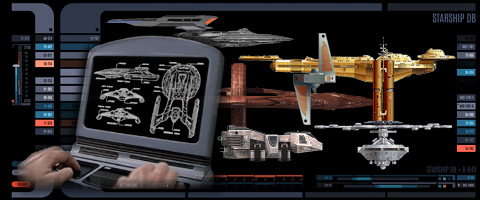
The database lists all canon starships and other spaceborne constructions of the Star Trek Universe by races and classes. Schematic side views and technical specs are included where available. The data is mainly based on the very episodes and on official sources. In some cases, however, obvious errors had to be corrected. Inconsistencies or oddities are discussed in the annotations. Read more about the database structure .
Random Page
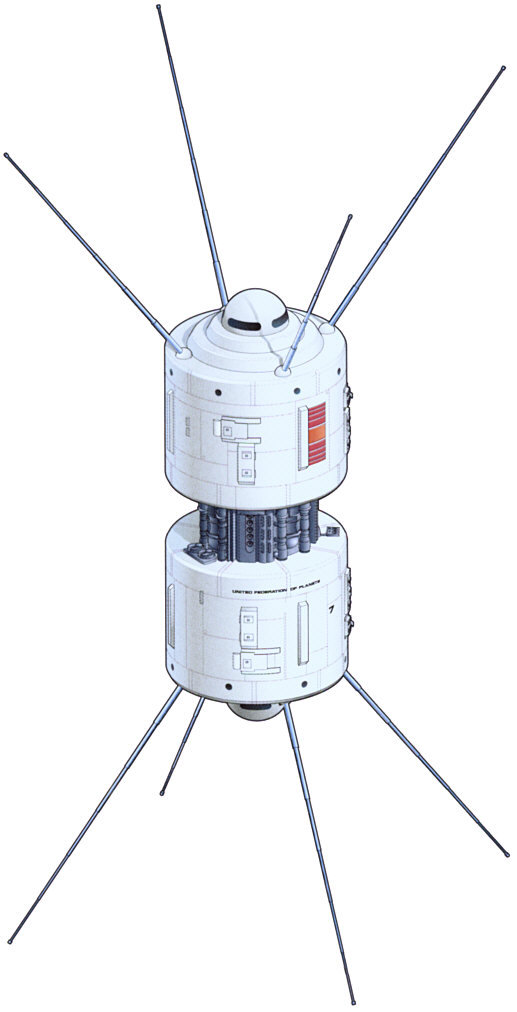
Pages with Recent Changes
- Discovery Future Alien Ship Classes 20 Apr 2024
- Lower Decks Alien Ship Classes 20 Apr 2024
- Starfleet Ship Classes A-K 20 Apr 2024
- Delta Quadrant Ships of Unknown Affiliation 10 Apr 2024
- Lower Decks Starfleet & Federation Ship Cl... 05 Apr 2024
- Fleet Charts in TIFF Format 31 Mar 2024
- Vulcan Ship Classes 31 Mar 2024
- Fleet Chart Annotations 31 Mar 2024
- Alpha and Beta Quadrant Ships L-R 31 Mar 2024
- Alpha and Beta Quadrant Ships A-E 31 Mar 2024
- Alpha and Beta Quadrant Ships of Unknown A... 31 Mar 2024
- Earth Ship Classes 31 Mar 2024
- Xindi Ship Classes 31 Mar 2024
- Romulan Ship Classes 31 Mar 2024
- Klingon Ship Classes 31 Mar 2024
- Other Starfleet Ship Classes 29 Mar 2024
- Delta Quadrant Ships L-R 28 Mar 2024
- Starfleet Ship Classes L-Z 24 Mar 2024
- Discovery Future Federation Ship Classes 17 Mar 2024
- Ancient or Mysterious Ships 17 Mar 2024
Structure of the Starship Database
Fleet Charts
Starship Articles
Starship Gallery
Earth & Federation
Starfleet Ship Classes A-K
Starfleet Ship Classes L-Z
Other Starfleet Ship Classes - uncertain and unknown
Civilian Federation Ship Classes
Federation Shuttlecraft - and other small auxiliary vehicles
Federation Probes - unmanned space vehicles
Federation Space Stations - fixed spaceborne installations
Federation Ground Transportation - bound to the ground
Earth Ship Classes - Pre-Federation (prior to 2161)
Future Ship Classes - of the 26th century and beyond
Major Aliens
Vulcan Ship Classes - Pre-Federation (prior to 2161)
Klingon Ship Classes - from all eras
Romulan Ship Classes - from all eras
Ferengi Ship Classes - from all eras
Cardassian Ship Classes
Bajoran Ship Classes
Dominion and Allied Ship Classes
Borg Ship Classes
Suliban Ship Classes
Xindi Ship Classes
Various Aliens
Alpha and Beta Quadrant Ships A-E
Alpha and Beta Quadrant Ships F-K
Alpha and Beta Quadrant Ships L-R
Alpha and Beta Quadrant Ships S-Z
Alpha and Beta Quadrant Ships of Unknown Affiliation
Gamma Quadrant Ships
Delta Quadrant Ships A-E
Delta Quadrant Ships F-K
Delta Quadrant Ships L-R
Delta Quadrant Ships S-Z
Delta Quadrant Ships of Unknown Affiliation
Anomalous Starships
Ancient or Mysterious Ships - whose owners don't show up
Space-Dwelling Lifeforms - organic or conscious vessels
Mirror Universe Ships - from TOS, DS9 and ENT
Confederation Timeline Ships - from PIC season 2
Non-Existent Ships - that were made up for varying reasons
Animated Star Trek
TAS Starfleet & Federation Ship Classes
TAS Alien Ship Classes

Prodigy Starfleet & Federation Ship Classes
Prodigy Alien Ship Classes
Abramsverse
Abramsverse Federation Ship Classes
Abramsverse Alien Ship Classes
Discovery Future Alien Ship Classes
Discovery Mirror Universe Ship Classes
Many of the images in this section are taken from official sources such as the Star Trek Encyclopedia II , the Star Trek Encyclopedia (2016) the DS9 Technical Manual , the Star Trek Fact Files , Star Trek: The Magazine or the Eaglemoss Official Starships Collection . Note that some of these were cleaned up and obvious errors were corrected. A number of schematics (namely Academy trainer craft, Antares NCC-501, Archer's model, Birdseye, Bonaventure from the Chronology , Centaur, Cheyenne, Constitution original, Excelsior variant 1, "Star Trek (2009)" shuttle, Mars defense perimeter, New Orleans, Ptolemy, Saladin, Springfield, Sydney, Raven, Talarian ships and variants, Tamarian ship and variants, Tosk ship and several TAS ships) are copyright of Ex Astris Scientia.
Special thanks go to Mike Swantak for the Ambassador, to Tim Davies for the Excelsiors, to Gus for the "Star Trek (2009)" Enterprise, to Sean Thornton for the Enterprise-A (alt.), to Pundus for the Odyssey, to MadMan and The-Didact for two versions of the Vengeance, to Chris G. for the "Star Trek (2009)" Spacedock, Klingon "Warbird" (models by MadMan), Whale Probe, "Nemesis" drydock (mesh by S-Stephen), TMP drydock (mesh by Prologic9), McKinley drydock (mesh by Eric Peterson), Warp Five Complex (mesh by Beda of Borg) and several images from Lower Decks, to Dávid Metlesits for the Klingon DIS ships (rendered based on models from Star Trek Adversaries), to Dave Combe for the DIS BoP and Sarcophagus ship, to C.HellenBrandt for the D'Arsay archive, Farpoint lifeform, interface probe, Melkotian buoy, ultraviolet satellite, standard D5, the "Star Trek (2009)" escape pod, forklift and more, to Ryan Church for Kirk's motorbike concept art, the Breen ship and the Klingon Augment ship, to Tobias Richter who created the USS Kelvin mesh, to James Chung for Picard concept art, to Daniel Petri for the reconstructed Aurora and the Class J from TOS-R, to Kristian Trigwell for Nomad, DY-100, DY-500, Valiant, Utopia Planitia, TAS personal spacecraft and some emblems, to Chris Spinnler for the Challenger, to Masaki Taniko who modified the Constitution refit, Miranda, Nebula variants, Curry and "Raging Queen", to Robert Bonchune for posting the official Intrepid-type, Delta ship and Kumari renders and who created many renders for recent official publications, to Doug Drexler for posting renders by several CGI artists such as Robert Bonchune, including the "Emmette", NX-Alpha, Arctic One, Arctic One Borgified, three-fingered drydock, multispatial probe, all Vulcan CGI ships, Cardassian workbee, 22nd century Ferengi ship, Nausicaan raider, all Suliban ships, Arkonian warship, Kreetassan ship, Kago Darr's shuttle, Malurian ship, Takret ship, Tandaran patrol ship, Valakian ship, Xantoran patrol ship, "Crossing" alien ship, Reptohumanoid ship and variants, Ledosian ships, Markonian outpost, Venatic, "Alice", "Silent Enemy" ship & shuttle and "Dead Stop" station, to John Eaves for the "Communicator" fighter, the Triannon vessel, the "Extinction" vessel, Xindi-Insectoid vessel 2 and the Axanar combat ship, to Irishman for drawings of Earth Starfleet ships, to Sven Lindemann for intermediate images, to Harry for parts of the early spaceship I, to Thorsten Junk for the Reman shuttle, to Raul Quiles who provided the Shuttlepod 1 and inspection pod schematics, to Kris Olinger who modified the Challenger, to Graham Kennedy for cleaning up and coloring the Starfleet probes, to Masao Okazaki for drawing the Daedalus, Bonaventure, Huron and TAS cargo drone, to Simon Golding for intermediate images, to E. Jakobsson for the Yeager and Elkins, to Jeff Russell for V'ger, to David Matteson for the NX-02 emblem, to viperaviator for the Franklin emblem, to Tobias Weimann for a couple of emblems, to Animaniac for the 22nd century Tholian ship and finally to Alice Orbán for subspace amplifier, Cardassian escape pod, Enolian vessels, Kobali shuttle, Malcorian ship, Malon freighter 2, Malurian shuttle, Mazarite shuttle & variants, Sikarian ship, Tarkalean freighter, Tellarite shuttle, Tsunkatse ship, Vissian ships, some of the Xindi ships, and several more.
Jörg Hillebrand has provided innumerable screen caps and invaluable observations. Most other screen caps are from TrekCore , Ariane's Star Trek Gallery , Cygnus-X1.net , Neutral Zone Starship Database or The Guardian of Forever. The photo of the Miranda-class USS Trial is courtesy of Larry Nemecek. Some images are based on Jim Stevenson's Starship Schematics . A reliable list of all canon starship appearances can be found in D. Joseph Creighton's The STArchive from where I extracted some useful data. Several facts about TAS ships came from Curt Danhauser's Guide to Animated Star Trek . I would also like to acknowledge The Unofficial Star Trek Fact Files Index, TrekMovie.com , Sector 0-0-1, Pedro's Shiporama, Frank Gerratana's Starfleet Ship Designs, Steve Pugh's Vessels of Starfleet, Adam Brooks , Adam Buckner, AJ, Alex Köhnen , Alexander Hartmann , Ambassador, Andrew Halliday, Andros, Andy Kinnear, B. J. Olejnik, Bounty, Brendan Stone , Brian Hunter, cardinal biggles, Colin , Dan Carlson , Daniel Anderson, DAS, doubleofive , Ed Bailey, Erich Mohr , Erik Filean, Florian Ollivier , Frank Bitterhof , George Nicolaides, Greg , Gvsualan , Harry , J , Jeff W, Jake Stotsky, Jason Schmus , Jim Morrissey , Jimmie R. Giboney, Jochen Gnida, John Mesiavech, Kevin , Kratisto, Lee McDonald , Lennier , Lester , Maik Leon Ehnert, Mariner Class, Mark Gill, Micah Haber, Michael Lanzinger, Mike , moreorlesser, Muchu, Paragon, Paul Doize, psycopunkn , Ralph Spitzner, Raymond J Impastato Jr, Rick , Rob Minnes, Robert, Scott Fletcher , Sol System, Stacy Smith, Stefan Posner, Stefan Rypalla , Stephen L. , Tadeo D'Oria, Thomas Owens , Thorsten , Trolleybus and Tuskin38 for ship pictures and information. Several more people helped me through their comments in the Flare Sci-Fi Forums . My special thanks to Colin and Boris S. who have provided lots of little-known information. Last but not least, special thanks to Michael Chabon and Dave Blass for sharing some information from behind the screen with us.

https://www.ex-astris-scientia.org/starship_database.htm
Last modified: 17 Mar 2024

© Ex Astris Scientia 1998-2024, Legal Terms
This website is not endorsed, sponsored or affiliated with CBS Studios Inc. or the Star Trek franchise.
Fleet Yards
- More to Explore
- Series & Movies
Published Jul 5, 2021
The Fleet's In: 24th Century Federation Starships
Does your favorite ship make the cut?
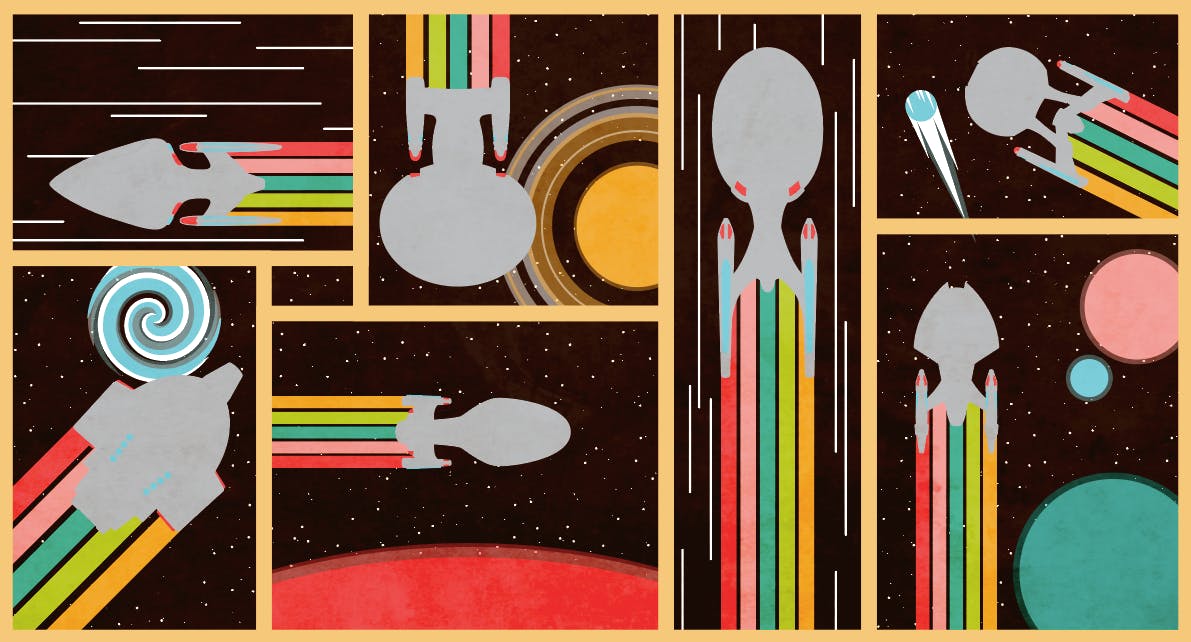
StarTrek.com
For those of us who lovingly refer to ourselves as “starship nerds,” Star Trek 's 24th century is populated with an astounding array of Starfleet vessels for us to gaze upon with awe. The series and films set in this era, namely Star Trek: The Next Generation , Star Trek: Deep Space Nine , Star Trek: Voyager , Star Trek: Picard , and the four movies helmed by the TNG crew, produced vast fleets that demonstrated the Federation's prestigious shipbuilding capabilities.
Narrowing down choices, and ranking my favorites proved difficult enough, so we have excluded 23rd century holdovers (so no Excelsior -, Miranda -, Constellation -, and Oberth -class staples), non-Starfleet vessels such as Ambassador Spock's craft from Star Trek (2009) , the relatively diminutive Danube -class runabouts, and auxiliary shuttles. With that in mind, let's take a look at the ships that have been deployed from Utopia Planitia, Riverside, Beta Antares, Eridani A, and other Federation fleet yards.
10. Nova -class in Voyager

When the Nova -class U.S.S. Equinox first popped up on U.S.S. Voyager 's sensors in “Equinox,” Captain Janeway noted that the starship was a planetary research vessel designed for scientific missions rather than long-range tactical excursions. The Nova -class bore streamlined similarities to its larger Intrepid and Sovereign -class cousins, but its limited scope and small crew left it vulnerable to a lonely jaunt through the Delta Quadrant. If Captain Ransom had commanded a sturdier vessel, perhaps he would not have resorted to the deplorable tactics he employed to find a faster route home. However, the design apparently stood an excellent chance of enduring, as Captain Harry Kim sat in the center seat aboard the Nova -class variant U.S.S. Rhode Island in the alternate future seen in “Endgame.”
9. Ambassador -class in The Next Generation and Deep Space Nine

The U.S.S. Enterprise-C remains the most well known Ambassador -class vessel due to its namesake, its prominence in the classic “Yesterday's Enterprise,” and its valiant rescue of the Klingon outpost on Narendra III from Romulan aggressors. Variants of this starship also notably appeared in Captain Picard's blockade during the Klingon Civil War, at the Battle of Wolf 359, and as a transport in “Data's Day.” The explorer's design proved to be an elegant mid-point between its Excelsior -class predecessors and Galaxy -class successors, and it would have been wonderful to see the vessel show up on a more frequent basis.
8. Prometheus -class in Voyager
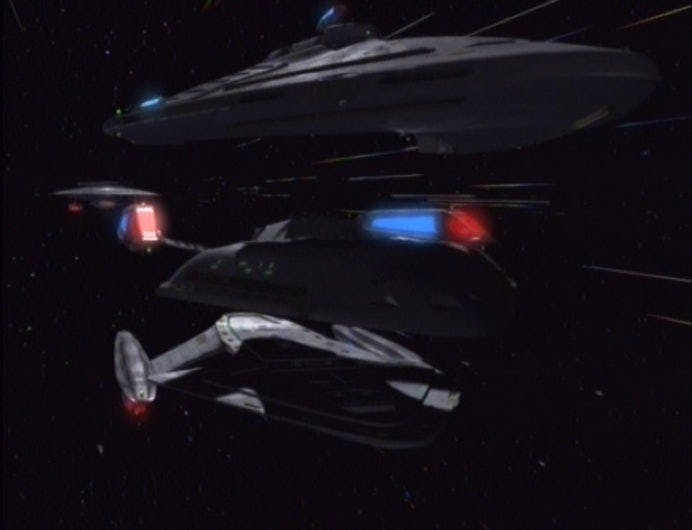
Who can forget the stunning sight of the prototype U.S.S. Prometheus becoming three independent vessels as it separated into multi-vector assault mode during “Message in a Bottle?” The Prometheus 's computer and resident EMH informed Voyager 's doctor that the advanced ship was intended for deep space tactical assignments and could achieve speeds faster than any other member of the fleet. The pair of holographic physicians managed to wrest control of the Prometheus from Romulan hands and deploy its experimental defensive systems against Tal Shiar warbirds. While it is unknown if further Prometheus -class ships were constructed, the prototype was spotted again as part of the armada sent to intercept the Borg sphere in “Endgame.”
Star Trek Ships of the Line — U.S.S. Prometheus
7. Akira -class in Star Trek: First Contact , Deep Space Nine , and Voyager
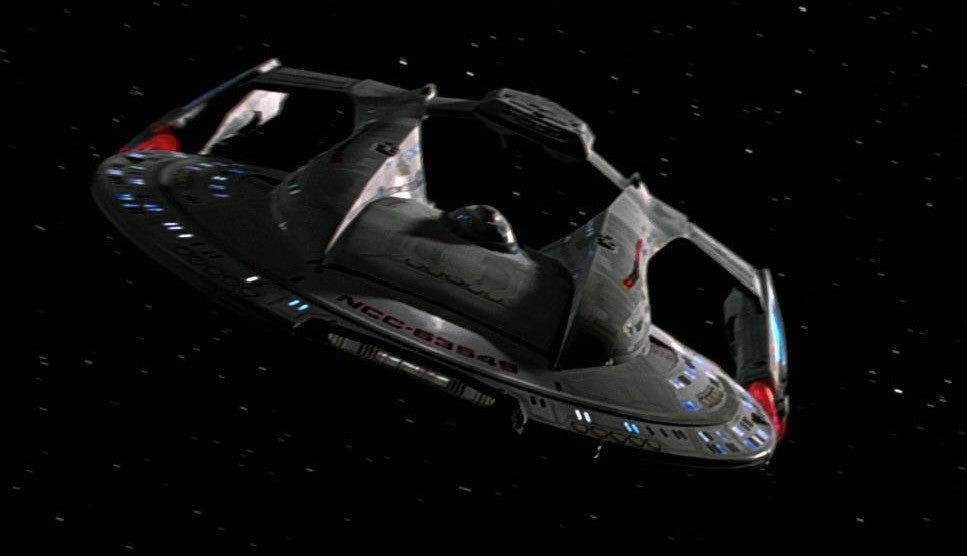
First seen on screen in the Battle of Sector 001, the Akira -class's earliest chronological appearance occurred during a flashback at the Utopia Planitia shipyards in the Voyager episode “Relativity.” While no single starship of this design ever received an excessive amount of attention, numerous Akira -class vessels substantiated their worth in battle during the height of the Dominion War. From retaking Deep Space 9 in “Sacrifice of Angels” to assaulting Cardassia in “What You Leave Behind,” these resilient craft evidently became an instrumental element in Starfleet's defense forces by the end of the 2370s.
6. Inquiry -class in Picard
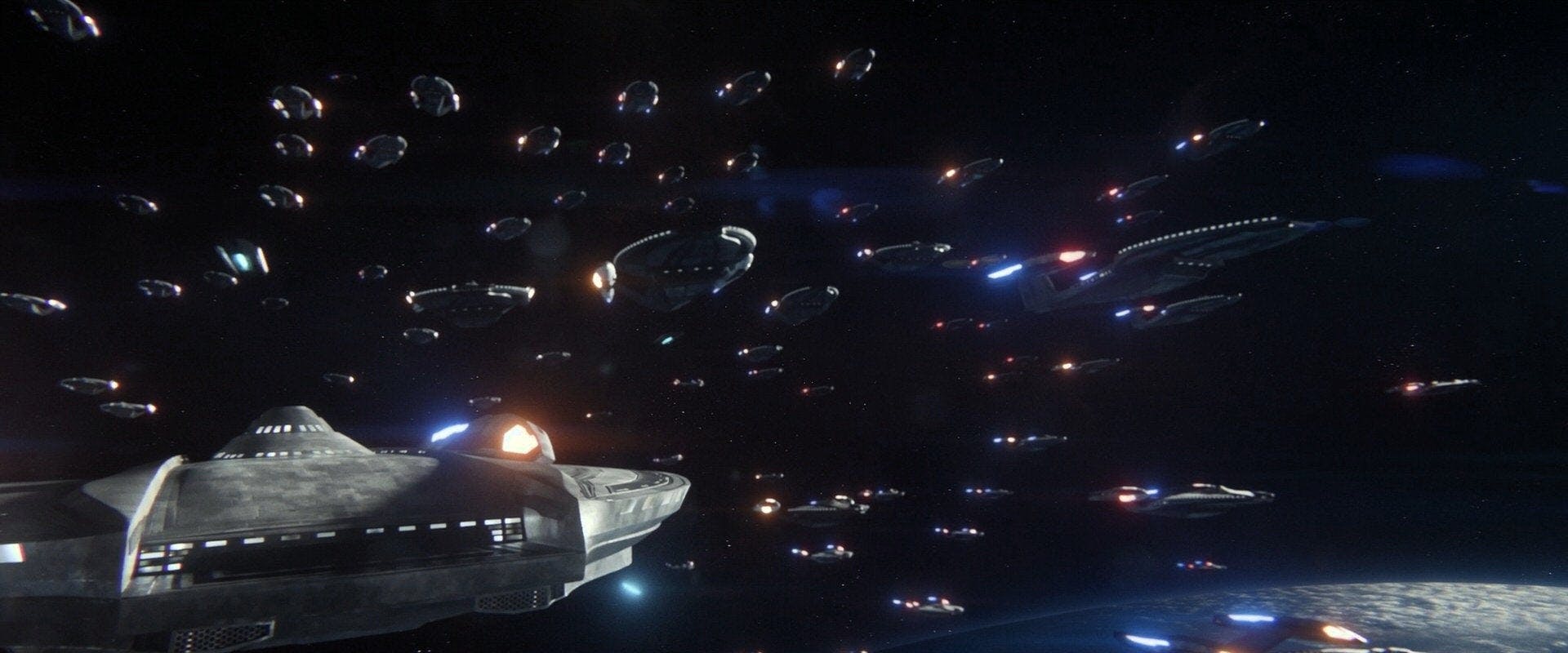
The imposing task force led by Captain Riker above Coppelius was composed of Inquiry-class vessels, including Riker's own U.S.S. Zheng He . Representing the most up-to-date Federation design of the 24th century, the reinstated captain described these ships as the toughest, fastest, and most powerful ones that Starfleet had ever produced up until that time. Although the entire fleet that confronted the Romulans in the Ghulion system fell into the Inquiry-class designation, there seemed to be two variants with differing nacelle configurations present. A whole armada of vessels more advanced than either the Galaxy - or Sovereign -classes? Now that is a majestic view to behold. I'd love to see a rundown of the entire roster of over 150 ships (by my latest count) that participated in Riker's defense formation.
5. Nebula -class in The Next Generation , Deep Space Nine , Voyager , Star Trek Generations , and Star Trek: First Contact
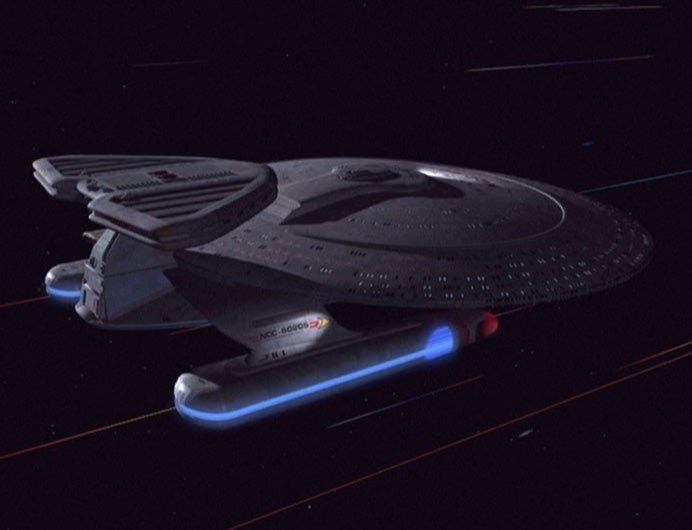
With primary hulls resembling those of its Galaxy -class counterparts, the Nebula -class explorers were featured heavily across multiple series and movies. Captain Maxwell demonstrated their tactical prowess as the U.S.S. Phoenix overwhelmed Cardassian targets in “The Wounded,” Data assumed temporary command over the U.S.S. Sutherland in “Redemption II,” the U.S.S. Farragut aided the U.S.S. Enterprise-D 's crew on Veridian III, and Professor Seyetik's U.S.S. Prometheus conducted solar experiments in “Second Sight.” The Nebula -class's diverse mission profile and extensive use over the years helped it secure such a high rank on our list.
4. Sovereign-class in Star Trek: First Contact , Star Trek: Insurrection , and Star Trek Nemesis

With its on screen credits confined to the U.S.S. Enterprise-E 's roles in the final three TNG films, the beautifully-fashioned Sovereig n-class is often considered to be an underutilized design by starship aficionados. However, given the class's appearances on background LCARS graphics in DS9, I would love to imagine that many Sovereigns were built and saw service somewhere just off-camera during those epic Dominion War battles. Geordi La Forge considered the Enterprise-E to be Starfleet's most advanced ship in 2373, and the new Federation flagship lived up to its reputation in engagements with the Borg, Son'a, and Praetor Shinzon's Scimitar . While not as voluminous as the Enterprise-D , Picard's latest command maintained a larger-than-life presence as it warped across the quadrant to extinguish diplomatic and strategic brush fires.
3. Defiant -class in Deep Space Nine , Star Trek: First Contact , and Voyager
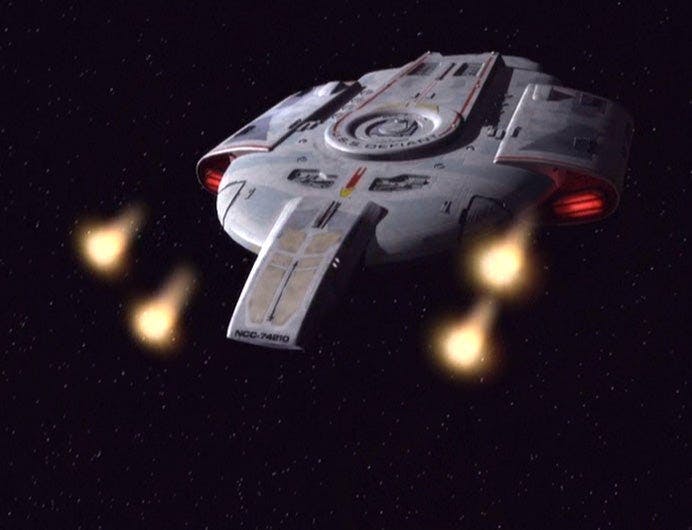
Riker's legendary quip about a “tough little ship” perfectly encapsulates the Defiant -class's ability to contain such overpowered weapons and defensive shields within such a small spaceframe. Originally developed to combat the Borg (which the U.S.S. Defiant bravely did under Worf's leadership at the Battle of Sector 001), Captain Sisko's beloved flagship ultimately earned its fiercest accolades in clashes against the Jem'Hadar both before and during the Dominion War. The only member of Starfleet to be (unofficially) considered a warship and (legally) equipped with a cloaking device, the Defiant withstood everything that was thrown at it... until a Breen energy-dampening weapon brought about its untimely end. The U.S.S. São Paulo , fittingly renamed in honor of its sister ship Defiant , allowed Sisko to oversee the Dominion's final defeat at Cardassia from a familiar bridge.
2. Intrepid -class in Voyager and Deep Space Nine
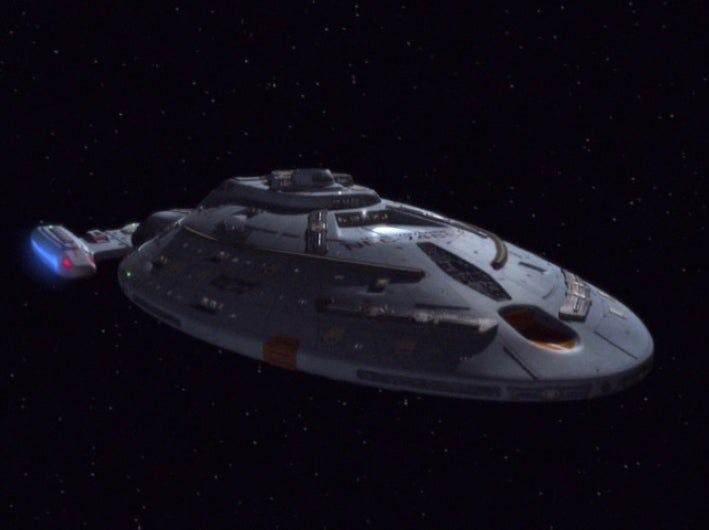
Home to Captain Janeway and her crew for their entire venture through the Delta Quadrant, U.S.S. Voyager pioneered Starfleet's use of bio-neural circuitry, the Emergency Medical Hologram, and a warp core that managed a top cruising speed of warp 9.975. Of course, Voyager also reaped the unique benefit of Seven of Nine's Borg database, a valuable library that permitted them to add a finely-tuned astrometrics lab and the Delta Flyer to the ship's already impressive complement. Voyager' s capacity to outlast everyone from the Hirogen to the Devore in a firefight while still completing countless scientific surveys and first contact missions served as a testament to its durability. When Admiral Ross visited Romulus during the height of the Dominion War, even the high-ranking officer opted to travel on the Intrepid -class U.S.S. Bellerophon rather than any other craft.
1. Galaxy -class in The Next Generation, Deep Space Nine, Voyager, Picard , and Star Trek Generations
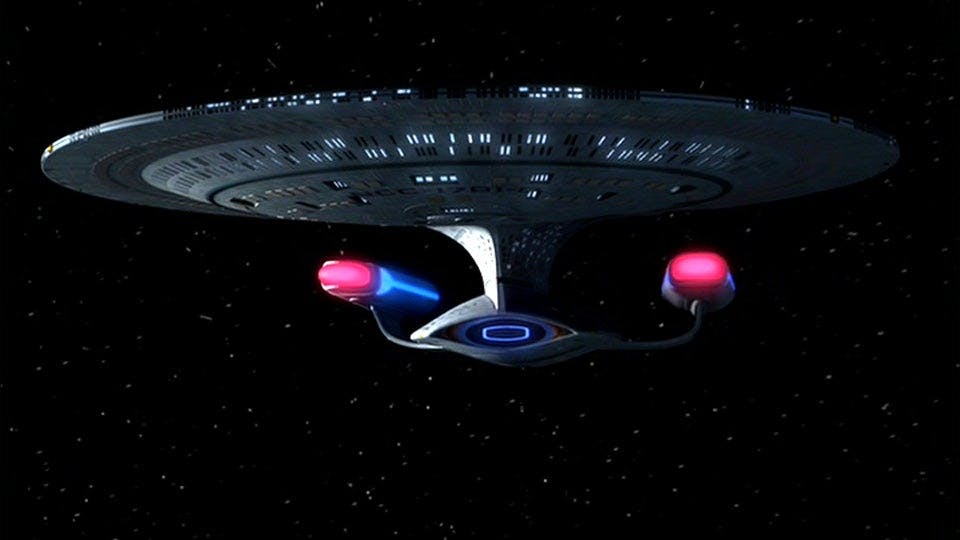
In what is sure to become a controversial decision, the Galaxy -class explorer tops our list of incredible Federation vessels. Despite early concerns over potential design flaws, the Enterprise-D and its sister ships acquitted themselves admirably from TNG's opening moments through Voyager 's return to Earth. Whether hosting dignitaries or being transported to regions beyond the Milky Way's confines, the Enterprise-D acted as a home and refuge for its crew and their families. Although the U.S.S. Odyssey fell in the Federation's first skirmish with the Jem'Hadar, other Galaxy-class starships held the line against the Dominion throughout the war. In the alternate version of 2390 depicted in “Timeless,” the U.S.S. Challenger remained in service under Captain Geordi La Forge. If the Galaxy -class is good enough for Starfleet's most accomplished 24th-century engineer, who am I to disagree?
Star Trek Ships of the Line — U.S.S. Enterprise
Jay Stobie (he/him) is a freelance writer who contributes articles to the official Star Trek website and Star Trek Magazine, as well as to Star Wars Insider and the official Star Wars website. Jay also serves as a part-time assistant and consultant advising many actors and creatives who work on his favorite sci-fi shows and films. He can be found on Twitter and Instagram at @StobiesGalaxy.
Star Trek: Picard streams on Paramount+ in the United States, n Canada on Bell Media’s CTV Sci-Fi Channel and streams on Crave, and on Amazon Prime Video in more than 200 countries and territories.
Get Updates By Email
Memory Beta, non-canon Star Trek Wiki
A friendly reminder regarding spoilers ! At present the expanded Trek universe is in a period of major upheaval with the continuations of Discovery and Prodigy , the advent of new eras in gaming with the Star Trek Adventures RPG , Star Trek: Infinite and Star Trek Online , as well as other post-57th Anniversary publications such as the ongoing IDW Star Trek comic and spin-off Star Trek: Defiant . Therefore, please be courteous to other users who may not be aware of current developments by using the {{ spoiler }}, {{ spoilers }} OR {{ majorspoiler }} tags when adding new information from sources less than six months old (even if it is minor info). Also, please do not include details in the summary bar when editing pages and do not anticipate making additions relating to sources not yet in release. THANK YOU
23rd century
- View history
The 23rd century was a century of Earth 's calendar , ranging from the years 2200 to 2299 and comprised of decades from the 2200s to the 2290s . Various stardate systems were in use in and around the United Federation of Planets , including stardates that range from numerals following approximately 200.0 (a 2250s stardate [1] ) to approximately 9500.0 (a 2290s stardate [2] ). Other stardating has this century run from stardates 2200.0 to 2299. [3]
- 1.1 Decades
- 2.2 References and notes
- 2.3 External link

Overview [ ]
Decades [ ].
- Robert April (b. 2194 )
- Pavel Chekov (b. 2245 )
- James T. Kirk (b. 2233 )
- Leonard McCoy (b. 2227 )
- Heihachiro Nogura
- Christopher Pike ( 2219 – 2320 )
- Sarek of Vulcan ( 2165 – 2368 )
- Montgomery Scott (b. 2222 )
- Spock of Vulcan (b. 2230 )
- Hikaru Sulu (b. 2237 )
- T'Pau of Vulcan (b. 2122 )
- Ael t'Rllaillieu
- Nyota Uhura (b. 2239 )
Appendices [ ]
- Star Trek: Early Voyages ( 2254 )
- Star Trek: Discovery (from 2256 )
- Star Trek: The Original Series ( 2264 - 2293 )
- Star Trek: Vanguard ( 2265 - 2270 )
- Star Trek: The Animated Series ( 2269 - 2270 )
- Star Trek: Challenger ( 2278 - 2280 )
- Star Trek: Starfleet Academy ( 2288 )
- Star Trek: The Lost Era ( 2293 - 2369 )
References and notes [ ]
- ↑ EV comic : " The Flat, Gold Forever ".
- ↑ TOS movie : The Undiscovered Country .
- ↑ TOS movie : Star Trek .
External link [ ]
- 23rd century article at Memory Alpha , the wiki for canon Star Trek .
- 23rd century article at Wikipedia , the free encyclopedia.
- 1 The Chase
- 2 Ferengi Rules of Acquisition
- 3 Preserver (race)
Star Trek: 10 Best Starfleet Ships Of The 24th Century
These Starfleet ships of Star Trek's 24th century are some of the most memorable among fans.
Star Trek 's twenty-fourth century has been explored extensively in TV series, games, and books. This bounty of content results in the era being one of Star Trek 's most fleshed-out periods. From the Dominion War to Starfleet's accidental exploration of the Delta Quadrant , the twenty-fourth century saw some of the Federation's greatest challenges.
RELATED: Star Trek: Best Starfleet Medical Officers
Luckily for the Federation, the Starfleet ships of the twenty-fourth century were more than up to the task. The century saw Starfleet throwing away the rule book to develop dedicated warships, experimenting with slipstream drives, and rebuilding its forces after catastrophic losses. It wasn't just the people of the era who made history—so too did the ships they crewed.
10 USS Phoenix
The Nebula-class USS Phoenix (best known for its appearance in TNG 's "The Wounded") was under the command of Captain Benjamin Maxwell. Maxwell, a veteran of the Federation–Cardassian Wars, believed that his former enemies were planning to reopen hostilities. To preclude this, he began to attack Cardassian ships, necessitating the intervention of the USS Enterprise-D in 2367.
It is likely that the Phoenix would have been destroyed by the Enterprise if not for the intervention of Miles O'Brien. The Enterprise transporter chief had previously served under Captain Maxwell and was able to convince the rogue officer to surrender. Although Maxwell's methods were reckless, he was in fact right—the Cardassian Union was rearming, and would soon pose a major threat to the Federation.
Although starships like the USS Enterprise receive much of the credit for preserving the Federation, the contribution made by the dependable USS Hood should not be overlooked. In 2366, the Excelsior-class starship supported the Enterprise-D near the Romulan Neutral Zone. Two years later, it again joined the Enterprise to expose Romulan involvement in the Klingon Civil War.
RELATED: Star Trek: Best Episodes From Each Series
The Hood served in and survived the Dominion War, while in 2379 it formed part of a battle group designed to intercept the Scimitar, a powerful Reman warship . Although it existed in the background of the twenty-fourth century, the USS Hood nonetheless played a number of crucial roles.
8 USS Aventine
While the canon status of the USS Aventine is debatable, this Vesta-class starship represented an important technological breakthrough for the Federation. The starship, best known for its frequent appearances in the Star Trek Relaunch novels, carried an advanced slipstream drive, allowing it to travel many times faster than a regular vessel at warp .
Following the death of its captain in 2381, the Aventine was commanded by Ezri Dax. The ship joined the Enterprise-E and the Titan in finally ending the Borg threat. In later years, the Aventine was deployed to counter the Breen and other Federation enemies.
7 USS Titan
The Luna-class USS Titan was the first ship to be captained by William Riker , who took command in 2379. Although the starship's adventures were initially documented in the questionable canon Star Trek: Titan novels, the starship is likely best known to fans for its appearances in Star Trek: Lower Decks .
In 2380, the Titan assisted the USS Cerritos during an engagement with the Pakleds. It continued to defend the Federation from the Pakled threat in subsequent months. In 2381, the son of William Riker and Deanna Troi was born aboard the Titan.
6 USS Protostar
The experimental USS Protostar was intended to further explore the Delta Quadrant following the return of the USS Voyager in 2378. As such, it was put under the command of Captain Chakotay, who had served as Voyager's first officer . However, the expedition went poorly, and the ship was captured by the Vau N'Akat, who planned to use the vessel to spread a deadly weapon into Federation space.
The starship actually remained dormant until it was rediscovered in 2383. A group of prisoners used the Protostar to escape the planet on which they were being held, although its journey back to the Federation resulted in the Vau N'Akat's weapon infecting many Starfleet ships. The Protostar itself was destroyed in the fallout, but its design served as the foundation for a new class of starships.
5 USS Cerritos
Although the USS Cerritos was built to perform logistical operations for the Federation, the California-class proved that even Starfleet's lesser ships played a pivotal role in the alliance's survival. Under the command of Captain Carol Freeman, the Cerritos specialized in second contact missions—administrative check-ups on civilizations previously contacted by the Federation.
RELATED: Best Lighthearted Star Trek Storylines
Despite this less-than-exciting mission profile, the starship proved essential in discovering the Pakleds' growing strength in 2380. The following year, the Cerritos proved itself in battle against the advanced USS Aledo, an AI-powered starship designed by a rogue Starfleet admiral .
4 USS Enterprise-E
Commissioned following the destruction of the Enterprise-D in 2371, the Sovereign-class Enterprise-E was larger and more heavily armed than its predecessor. This armament proved necessary during an engagement with the Borg in 2373, during which the starship traveled over three centuries back in time.
Despite its strength, the Enterprise-E played a minimal role in the Dominion War of 2373 to 2375, although Captain Picard and his crew did intervene on behalf of the agrarian Ba'ku when the Federation Council attempted to relocate the species. Perhaps the Enterprise-E's most notable engagement was against the Scimitar in 2379, although it was heavily damaged during the battle.
3 USS Voyager
When the USS Voyager traveled to the Badlands to intercept a Maquis vessel in 2371, its crew could not imagine the fate that awaited them. Both the Intrepid-class starship and its prey were transported to the Delta Quadrant, and the two crews were forced to put their differences aside in order to make the 70,000-light-year journey home.
This seven-year journey saw Captain Janeway and her crew encounter many new alien races, including the Kazon and Species 8472 . The USS Voyager also regularly encountered the Borg, with one member of the collective joining the starship's crew. Voyager's legacy endured for centuries—the ship was still remembered, albeit inaccurately, by Kyrian historians in the year 3074.
2 USS Defiant
While the Dominion War involved many factions and was fought on several fronts, many of its key engagements involved a single ship: the USS Defiant. This experimental warship dispensed with Starfleet's standard doctrine. Rather than focusing on exploration or carrying civilians, the Defiant was built to combat the Borg—and later, of course, the Dominion.
RELATED: Best Starfleet Ships During The Dominion War
In 2371, the Defiant-class starship made first contact with the Dominion's Founders. In 2373, it joined a flotilla of Starfleet vessels in Sector 001 in an attempt to repel a Borg cube. The Defiant liberated the Deep Space Nine from Dominion forces in 2374 and participated in both battles for control of the Chin'toka system. However, it was destroyed by a Breen energy weapon during the second engagement.
1 USS Enterprise-D
The Enterprise-D was, without a doubt, one of the most significant vessels in Federation history. As well as making dozens of first contacts (including with the Borg and the Q Continuum ), the Galaxy -class starship carried out significant exploration and research during its time as the flagship of the Federation. Much of the starship's success can be attributed to its crew, including Captain Picard, Commander Riker, and Lieutenant Commander Data, key figures in Starfleet history.
Although it was extensively damaged over Veridian III in 2371, the Enterprise-D was partially rebuilt by Geordi La Forge at the Fleet Museum. This refitted vessel fought against the Borg in 2401, demonstrating that, despite its age, the Enterprise-D remained a legendary part of the Federation fleet.
MORE: Star Trek: Best Starfleet Ships Of The 23rd Century
- Starfleet Academy (23rd Century)
- Vendors accepting Energy Credits
- Vendors buying at 50%
Ship Equipment Vendor (23rd century)
- VisualEditor
- View history
- 1.1 Weapons
- 1.2 Deflector Dish
- 1.3 Impulse Engine
- 1.4 Ship Shield
- 1.5 Warp Core
- 1.6 Secondary Deflector
- 1.7 Consumables
Store [ | ]
Weapons [ | ], deflector dish [ | ], impulse engine [ | ], ship shield [ | ], warp core [ | ], secondary deflector [ | ], consumables [ | ], notes [ | ].
- Unlike most other Ship Equipment Vendors, this vendor does not sell any Hangar Pets .
- 1 Playable starship
- 2 Infinity Prize Pack - T6 Ship
Screen Rant
Who was airiam star trek: discovery’s tragic cyborg officer explained.
Everything you need to know about Lt. Commander Airiam, the 23rd century cyborg Starfleet officer in Star Trek: Discovery, and her tragic story.
Warning: This Article Contains SPOILERS For Star Trek: Discovery Season 5, Episode 4, "Face the Strange".
- Star Trek: Discovery season 5 episode 4 brought back Lt. Commander Airiam, who died in season 2.
- Airiam was an augmented human USS Discovery officer who was taken over by the enemy A.I. Control.
- Airiam was played by Sara Mitich in Discovery season 1 and Hannah Cheesman in season 2; Cheesman returned as Aiiam in season 5.
Star Trek: Discovery shockingly brings back Lt. Commander Airiam (Hannah Cheesman) in Star Trek: Discovery season 5, episode 4 , "Face the Strange", written by Sean Cochran and directed by Lee Rose. Captain Michael Burnham (Sonequa Martin-Green), Commander Rayner (Keith Callum Rennie), and Commander Paul Stamets (Anthony Rapp) are forced to hop through different eras of the USS Discovery's past and future. Their time travel puzzle places the trio back in Star Trek: Discovery season 1, when the USS Discovery was commanded by Captain Gabriel Lorca (Jason Isaacs). Instead of Lorca, however, Burnham finds that Airiam is in command, a year before Airiam's death in Star Trek: Discovery season 2.
The cyborg Airiam's unique appearance stands out among the mostly human characters in Star Trek: Discovery , inviting curiosity as to Airiam's origin. With striking blue eyes and facial features divided into pale white and silver chrome segments, Airiam could have been a member of an alien species new to Star Trek: Discovery , like the Kelpien Commander Saru (Doug Jones), or a 23rd-century synthetic life form, like a precursor to Star Trek: The Next Generation 's Lt. Commander Data (Brent Spiner). Neither an alien nor an early android, Lt. Commander Airiam was an augmented human, enhanced with cybernetic parts after a shuttle accident that left Airiam in critical condition and killed Airiam's new husband.
Star Trek: Discovery Season 5 Returning Cast & New Character Guide
Who was airiam & how did she die in star trek: discovery, airiam sacrificed herself to protect the future of sentient life..
Lt. Commander Airiam was a cyborg science officer who served on the USS Discovery in Star Trek: Discovery seasons 1 & 2, and often took command of Discovery when the Captain and First Officer were not available. As the spore drive operations officer, Airiam worked as a liaison between Discovery's command crew on the bridge and Lt. Commander Paul Stamets in engineering. Airiam was close with the rest of the USS Discovery's bridge crew, and counted Ensign Sylvia Tilly (Mary Wiseman), Lt. Joann Owosekun (Oyin Oladejo), and Lt. Keyla Detmer (Emily Coutts) as some of her closest friends. Burnham didn't know Airiam well then, but would soon.
Airiam's enhancements were sometimes a boon, like when processing 10,000 years of data from the Sphere, but also ultimately led to Airiam's death in Star Trek: Discovery season 2, episode 9, "Project Daedalus". Control, the threat assessment A.I. developed by Starfleet's Section 31, hijacked Airiam through her cybernetic augmentation to get to the Sphere data, with the goal of becoming sentient and wiping out sentient life. Control managed to get 25% of the Sphere data before Airiam realized her death would be the only way to stop Control. Airiam pleaded with Burnham and Lieutenant D. Nhan (Rachael Ancheril) to release Airiam from an airlock, and Nhan ultimately complied.
In Star Trek: Discovery season 3, Lt. Nhan stays on the USS Discovery in the 32nd century to honor Lt. Commander Airiam's sacrifice.
2 Actors Played Airiam In Star Trek: Discovery
Sara mitich and hannah cheesman both played lt. commander airiam..
Star Trek: Discovery 's Lt. Commander Airiam was played by two different actors, starting with Sara Mitich playing Airiam in Star Trek: Discovery season 1. Mitich may have had an allergic reaction to the cyborg makeup, which would prevent her continued performance as Airiam after Star Trek: Discovery season 1. Instead of leaving, Airiam's original actress played Lt. Nilsson , a new human character, beginning in Star Trek: Discovery season 2. After Airiam's death, Nilsson took over the role of spore drive ops officer, and stayed on the USS Discovery in the 32nd century until Star Trek: Discovery season 5, when Nilsson transferred to the USS Voyager-J.
Hannah Cheesman took over the role of Lt. Commander Airiam in Star Trek: Discovery season 2, and played Airiam again in Star Trek: Discovery season 5, episode 4, "Face the Strange". Although the episode revisited Discovery season 1, when Sara Mitich played Airiam, it made sense that Airiam's second actress, Hannah Cheesman, returned to Star Trek: Discovery . The story relies on having a consistent through line from the connection between Cheesman's Airiam and Michael Burnham before Airiam's tragic death in Star Trek: Discovery season 2, episode 9, "Project Daedalus", and Airiam and Burnham meeting in Discovery season 5, episode 4, "Face the Strange".
Hannah Cheesman also plays a fully human version of Airiam seen in flashback recordings from before Airiam's accident in Star Trek: Discovery season 2, episode 9, "Project Daedalus".
Why Airiam Was Key To Star Trek: Discovery Season 5’s Time Travel
Burnham's knowledge of airiam's death proved valuable..
Lt. Commander Airiam was the key to solving the time travel problem in Star Trek: Discovery season 5, episode 4, "Face the Strange". Stamets' plan to contain the time bug by breaking Discovery's warp bubble required cooperation from Discovery's bridge crew in order to work, an impossible task to achieve at a time when Discovery's captain was Captain Gabriel Lorca (Jason Isaacs) and Michael Burnham was considered an untrustworthy mutineer. Fortunately, the duty roster revealed Lorca was not on the USS Discovery , and Airiam was in command, so Captain Burnham's job of convincing the bridge crew to help was downgraded from impossible to merely difficult.
Although Burnham wasn't particularly close to Lt. Commander Airiam, Michael was present when Airiam died, and privy to all the pain of Airiam's last moments. Burnham's testimony of Airiam's death was met with protest from Detmer and Owosekun but unlocked a solemn understanding from Airiam herself. Airiam knew herself, and what she would do, far better than even her friends did. Convinced that Burnham was telling the truth about being from the future, Airiam allowed the plan to proceed, and helped get the USS Discovery out of its time loop. Just like in Discovery season 2, Lt. Commander Airiam's trust saved the future in Star Trek: Discovery season 5.
Star Trek: Discovery streams Thursdays on Paramount+.
Star Trek: Discovery

Starfleet personnel (23rd century)
- View history
The following is a list of Starfleet personnel who served during the 23rd century .
See also [ ]
- Unnamed Starfleet personnel
- April, Robert
- April, Sarah
- Arakelian, D.
- Bailey, Dave
- Barrows, Tonia
- Berman, Rick K.
- Boyce, Phil
- Braga, Brannon
- Bryce, Randi
- Chapel, Christine
- Chekov, Pavel A.
- Chin-Riley, Una
- Coleman, Arthur
- Comsol, Robert L.
- Decker, Matthew
- Decker, Will
- Dehner, Elizabeth
- Dominguez, José
- Esteban, J.T.
- Farrell, John
- Finney, Benjamin
- Fitzpatrick
- Fleck, Jerry
- Fletcher, R.
- Franklin, Matt
- Galway, Arlene
- Garrovick (Captain)
- Garrovick, David (Ensign)
- Graffeo, C.
- Galliulin, Irina
- Haines, Jana
- Hansen (Commander)
- Hansen (Lieutenant)
- Harriman, John
- Jaeger, Carl
- Jennings, J.R.
- Johansson, Helen
- K'Bentayr, Alnschloss
- Kirk, George
- Kirk, James T.
- Kirk, Winona
- Komack, James
- Landon, Martha
- Lawton, Tina
- Lester, Janice
- Lindstrom (sociologist)
- Lindstrom (Captain)
- Markel, Tom
- Martine, Angela
- Masters, Charlene
- M'Benga, Joseph
- McCoy, Leonard H.
- McGivers, Marla
- Mendez, José I.
- Merik, R.M.
- Minor, M.C.
- Mitchell, Gary
- Mitchell, Jenna
- Moreau, Marlena
- Mulhall, Ann
- Nellis, Tom
- Noel, Helen
- Nored, Anne
- Palamas, Carolyn
- Pike, Christopher
- Piper, Mark
- Pitcairn (Chief)
- Pitcairn (Lieutenant)
- Preston, Peter
- Rand, Janice
- Randolph, Joel
- Randolph, Nancy
- Rescher, G.
- Riley, Kevin
- Robau, Richard
- Roddenberry, Gene
- Rodriguez, Esteban
- Romaine, Jacques
- Romaine, Mira
- Ross, Teresa
- Scott, Montgomery
- Shaw, Areel
- Styles, Lawrence H.
- Sulu, Demora
- Sulu, Hikaru
- Terrell, Clark
- Thompson, Leslie
- Tomlinson, Robert
- Tormolen, Joe
- Tracey, Ronald
- Tracy, Karen
- Tyler, José
- Uhura, Nyota
- Valtane, Dimitri
- Walking Bear
- Watkins, John B.
- Wesley, Bob
- Westervliet
- Wilson (Commander)
- Wilson (Crewman)

Starship Simulator is More Star Trek than Star Citizen
Built on a foundation of real-world space science and architectural design, Fleetyard Studios’ upcoming Starship Simulator promises an entire galaxy to explore on a realistic and detailed ship and a campaign charting the future of human space exploration. It's something that should be right up any Sci-Fi or simulation game fans' alley, and that's clear in how successful its Kickstarter has been, with it far exceeding its initial goal.
Interested Sci-Fi fans can check out Starship Simulator's Kickstarter HERE
Players can take their ship out into the vastness of space and take on the roles of various potential crew positions while using concepts from actual physics in pursuit of the popular subgenre of hard science fiction . For instance, ships in Starship Simulator are able to leap from system to system using the faster-than-light drive theory proposed by Miguel Alcubierre and honed by Erik Lentz. Distances between stars are accurate, and so many research papers were consulted in the game’s design. Game Rant recently spoke with Fleetyard’s director, Dan Govier, about this entire approach to Starship Simulator and the number of comparisons it has drawn.
8 Games With the Most Realistic Space Exploration
That probably sounds familiar, in that it's a premise that is reflected in plenty of major games, in particular games like Starfield , which also adopts a hard sci-fi approach to some degree. The idea of a space sandbox where realistic technology powers the future of human expansion is popular in games, and the idea of incorporating more accurate science has been a major selling point for the genre of space sandboxes itself.
Starship Simulator Takes Star Citizen Comparisons as a Compliment
In particular, the fact that Starship Simulato r is coming off a successful Kickstarter with grand ambitions and is funding itself in part through selling ships as DLC draws comparisons to the goliath project of Star Citizen . Govier doesn’t think it’s a particularly apt comparison. However, he does think the comparison flatters his comparatively smaller and less-funded team.
I mentioned to someone recently that being compared to Star Citizen , when we have a tiny team and a very, very small budget versus multiple studios with over half a billion dollars in funding, we take that as a compliment really, to be compared at that scale…We’re just completely separate products.
Instead of being an MMO live service game , explained Govier, Starship Simulator is a game where the player steps into the shoes of a member of a wider crew, some of whom could be other players in a multiplayer co-op environment. It can also be played entirely solo, using NPCs to fill out the rest of the crew.
For Starship Simulator to prevent the feature creep that has largely defined over a decade of alpha testing with Star Citizen , Fleetyard has taken pains to closely control the focus of its game’s development, including transparency in the studio’s process and a firmly-set roadmap through the game’s planned development. Govier said he doesn’t want to be waylaid by cool ideas, which is an understandable position.
Those differences permeate throughout the game far deeper, however. Govier explained that Star Citizen focuses on a personal journey seeking wealth and bigger and better ships through daring combat. By contrast, Starship Simulator is focused on the future of humanity as a whole and an individual’s place in it. Starship Simulator is more concerned with exploring space, engaging with the science upholding the universe, and meeting new alien races. Starship Simulator players would engage in combat as a result of failed diplomacy, instead of as a means to an end. The motivation of wealth is less important than the motivation of discovery.
We're more about being a part of a crew living and working in space. We focus on the exploration side of it, exploring the galaxy and seeing what's out there, with combat and conflict being generally a consequence of failed diplomacy, rather than the main gameplay loop…We want to be different. We want to focus on that science and that exploration and progressing humanity in that way.
In short, Starship Simulator wants its players to boldly go where no one has gone before.
Starship Simulator is 'Star Trek, but Realistic'
The more apt comparison for Govier is the idea that Starship Simulator is a more grounded Star Trek . Those influences can be seen throughout the game, leaving its fingerprints on things like ship architecture, crew dynamics, and uniform design. It also vibes more with the notions of exploration and wonder that have been characteristic of Star Trek at its best. This influence is pretty baked into the development of the game, with Star Trek ’s design for ships being a major piece of the design ethos of Starship Simulator ’s fleet, along with modern architects. The Alcubierre Drive that the game uses to power its faster-than-light flight even shares a lot of traits with Star Trek ’s warp drive , but it is adapted to actual physics.
I think you could probably describe what we're doing as Star Trek , but realistic. How would we really do it? If we wanted that Star Trek -style future for humanity, as it stands, how would we do that? I think, in some ways, many aspects of Star Trek aren't realistic, and they're perhaps a little too clean and not very human. We're looking at this from the perspective of being human. How would humans actually do this?
The focus Govier expressed on science and the wonder of space travel are also baked into the DNA of what makes Star Trek what it is. It’s no understatement to say that the passion Star Trek has inspired for science and technology is utterly unique and that influence is still prevalent today. Facts of everyday life like cell phones, touchscreens, 3D printers, and more gained popularity as part of Star Trek ’s vision of future technology to such an extent that the current era of the franchise had to update expectations of the 23rd century to still seem futuristic for Star Trek Discovery .
That, too, is something Govier hopes to be a part of. The amount of research Fleetyard put into the game means that just playing it can be passively educational, and there are hopes that Starship Simulator can even be used as a tool to teach and inspire space enthusiasts like Govier himself. The game’s O-type stars behave like O-type stars, its readouts are accurate, the electrical engineering on the ship is accurately designed, and even the layout of the galaxy is as accurate as it can be.
For someone who's coming into it maybe as a space enthusiast, but not as someone who knows those things yet, you can literally learn actual astrophysics just by playing the game. One of my dreams is to have an astronomer with a class of students all together on the ship, learning astronomy by actually flying around the solar system and looking at all the different planets. I think that would be really cool. I'd love to see the game used as an educational tool .
Science fiction in general has had a major role in inspiring people, from a love of space to designing tools and technology to exploring the frontiers of creativity. By its nature, science fiction asks people to imagine what the future will be. The future that Starship Simulator invites may be more grounded and human than Star Trek at its height, but it’s no less brazen in its advocacy for science and the bullish view it takes on human nature.
Starship Simulator will enter Early Access on Steam in late 2024/early 2025.
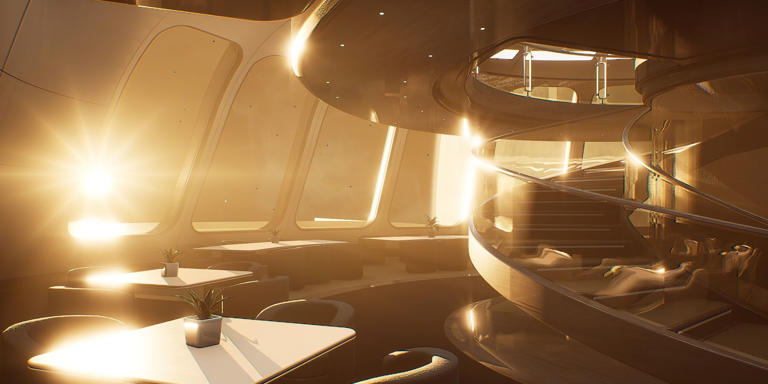
Advertisement
Supported by
Original ‘Star Trek’ Enterprise Model Is Found After Being Missing for Decades
The 33-inch model surfaced on eBay after disappearing around 1979. An auction house is giving it to the son of Gene Roddenberry, the creator of “Star Trek.”
- Share full article

By Emily Schmall
The first model of the U.S.S. Enterprise, the starship that appeared in the opening credits of the original “Star Trek” television series , has been returned to Eugene Roddenberry Jr., the son of the creator of the series, decades after it went missing.
“After a long journey, she’s home,” Mr. Roddenberry wrote on social media on Thursday.
For die-hard Trekkies, the model’s disappearance had become the subject of folklore, so an eBay listing last fall, with a starting bid of $1,000, didn’t go unnoticed.
“Red alert,” someone in an online costume and prop-making forum wrote, linking to the listing.
Mr. Roddenberry’s father, Gene Roddenberry, created the television series, which first aired in 1966 and ran for three seasons. It spawned numerous spinoffs, several films and a franchise that has included conventions and legions of devoted fans with an avid interest in memorabilia.
The seller of the model was bombarded with inquiries and quickly took the listing down.
The seller contacted Heritage Auctions to authenticate it, the auction house’s executive vice president, Joe Maddalena, said on Saturday. As soon as the seller, who said he had found it in a storage unit, brought it to the auction house’s office in Beverly Hills, Calif., Mr. Maddalena said he knew it was real.
“That’s when I reached out to Rod to say, ‘We’ve got this. This is it,’” he said, adding that the model was being transferred to Mr. Roddenberry.
Mr. Roddenberry, who is known as Rod, said on Saturday that he would restore the model and seek to have it displayed in a museum or other institution. He said reclaiming the item had only piqued his interest in the circumstances about its disappearance.
“Whoever borrowed it or misplaced it or lost it, something happened somewhere,” he said. “Where’s it been?”
It was unclear how the model ended up in the storage unit and who had it before its discovery.
The original U.S.S. Enterprise, a 33-inch model, was mostly made of solid wood by Richard C. Datin, a model maker for the Howard Anderson Company, a special-effects company that created the opening credits for some of the 20th century’s biggest TV shows .
An enlarged 11-foot model was used in subsequent “Star Trek” television episodes, and is now part of the permanent collection of the Smithsonian National Air and Space Museum , where it was donated by Paramount Studios in 1974.
Mr. Roddenberry, who said he gave the seller a “reward” for its recovery but did not disclose the terms, assembled a group of “Star Trek” production veterans, model makers and restoration specialists in Beverly Hills to authenticate the find.
The group included a “Star Trek” art supervisor, Michael Okuda, and his wife, Denise, an artist on “Star Trek” television series and films, and Gary Kerr, a “Trek x-pert” who served as technical consultant for the Smithsonian during a 2016 restoration of the 11-foot model.
“We spent at least an hour photographing it, inspecting the paint, inspecting the dirt, looking under the base, the patina on the stem, the grain in the wood,” Mr. Roddenberry said.
“It was a unanimous ‘This is 100 percent the one,’” he said.
Gene Roddenberry, who died in 1991 , kept the original model, which appeared in the show’s opening credits and pilot episode, on his desk.
Mr. Kerr compared the model to 1960s photos he had of the model on Mr. Roddenberry’s desk.
“The wood grain matched exactly, so that was it,” he said on Saturday.
The model went missing after Mr. Roddenberry lent it to the makers of “Star Trek: The Motion Picture,” which was released in 1979, Mr. Maddalena said.
“This is a major discovery,” he said, likening the model to the ruby slippers from “The Wizard of Oz,” a prop that was stolen in 2005 and recovered by the F.B.I. in 2018, and that Heritage Auctions is selling.
While the slippers represent hope, he said, the starship Enterprise model “represents dreams.”
“It’s a portal to what could be,” he said.
Emily Schmall covers breaking news and feature stories and is based in Chicago. More about Emily Schmall
Explore More in TV and Movies
Not sure what to watch next we can help..
As “Sex and the City” became more widely available on Netflix, younger viewers have watched it with a critical eye . But its longtime millennial and Gen X fans can’t quit.
Hoa Xuande had only one Hollywood credit when he was chosen to lead “The Sympathizer,” the starry HBO adaptation of a prize-winning novel. He needed all the encouragement he could get .
Even before his new film “Civil War” was released, the writer-director Alex Garland faced controversy over his vision of a divided America with Texas and California as allies.
Theda Hammel’s directorial debut, “Stress Positions,” a comedy about millennials weathering the early days of the pandemic , will ask audiences to return to a time that many people would rather forget.
If you are overwhelmed by the endless options, don’t despair — we put together the best offerings on Netflix , Max , Disney+ , Amazon Prime and Hulu to make choosing your next binge a little easier.
Sign up for our Watching newsletter to get recommendations on the best films and TV shows to stream and watch, delivered to your inbox.

IMAGES
VIDEO
COMMENTS
The 23rd century, defined in the calendar of Earth as being from 2201 until 2300, was a period of expansion for the United Federation of Planets, with Humans and other founding species, such as Vulcans, at the forefront of exploration. The Federation's exploration agency Starfleet would make first contact with numerous intelligent species and civilizations, including the Talosians, the First ...
The U.S.S. Enterprise, one of the most famous Starfleet ships of the 23rd century. The 23rd Century is a span of 100 Earth years that started in 2201 and ended in 2300. The century is defined by several conflicts among the powers of the Alpha and Beta Quadrants of the Galaxy. Despite constant threats, the United Federation of Planets faces an ...
Starfleet Ships of the Early 23rd Century. In the second half of the 22nd century, Starfleet helped the young Federation become a galactic superpower. Its starships could travel farther and faster than those of any other fleet. As a result, Starfleet was often the first to explore uninhabited sectors, to survey solar systems, and to identify ...
Akyazi class perimeter action ship. From Ships of the Star Fleet, Volume 2. Sub-classes. Akyazi In service from 2286. 36 vessels (all new builds). NCC-1010 to NCC-1047. All ship names begin with A, B or E. Arbiter In service from 2286. 41 vessels (all new builds). NCC-1048 to NCC-1089. All ship names begin with A, J or T.
22nd and early 23rd Century Classes. This page is about those classes that were in service in the period between the time of the Romulan War and the launching of the first ships with the familiar original series styling. This period is roughly between the dates 2160 and 2220. [ Marshall] [ Daedalus] [ Bonaventure] [ Caracal] [ Horizon] [ Mann ...
Star Trek 's 23rd century is a key period in the franchise's internal history. Some of Starfleet's most notable figures, such as Kirk, Spock, Burnham, and Pike, operated during this time, and the ...
The database lists all canon starships and other spaceborne constructions of the Star Trek Universe by races and classes. Schematic side views and technical specs are included where available. ... Discoverse Alien Ship Classes - 23rd century, from DIS and SNW. Discoverse Klingon Ship Classes - 23rd century, from DIS and SNW. Discovery Future ...
Star Trek Shipyard is your ultimate resource for exploring the incredible starships that have graced the vast expanse of the Star Trek universe. ... to the USS Enterprise NCC-1701 in terms of both size and firepower when they were on the Klingon front line in the late 23rd century. Learn More. USS Voyager. Intrepid class. Length 344.5 m.
The imposing task force led by Captain Riker above Coppelius was composed of Inquiry-class vessels, including Riker's own U.S.S. Zheng He.Representing the most up-to-date Federation design of the 24th century, the reinstated captain described these ships as the toughest, fastest, and most powerful ones that Starfleet had ever produced up until that time.
The 23rd century was a century of Earth's calendar, ranging from the years 2200 to 2299 and comprised of decades from the 2200s to the 2290s. Various stardate systems were in use in and around the United Federation of Planets, including stardates that range from numerals following approximately 200.0 (a 2250s stardate) to approximately 9500.0 (a 2290s stardate). Other stardating has this ...
This article discusses the fictional timeline of the Star Trek franchise.The franchise is primarily set in the future, ranging from the mid-22nd century (Star Trek: Enterprise) to the late 24th century (Star Trek: Picard), with the third season of Star Trek: Discovery jumping forward to the 32nd century.However the franchise has also outlined a fictional future history of Earth prior to this ...
Published Sep 19, 2023. These Starfleet ships of Star Trek's 24th century are some of the most memorable among fans. Star Trek 's twenty-fourth century has been explored extensively in TV series ...
List of unnamed Federation starships in service during the 23rd century. Charlie's transport was a ship that suffered a crash landing on the planet Thasus circa 2252. Losing his parents in the crash, Charles Evans was the sole survivor. It was equipped with microtapes and enough food concentrates to last approximately a year, according to Spock. When Doctor Leonard McCoy expressed doubt in ...
This draws a direct link with Star Trek: Discovery, suggesting that the nature of starfleet construction in the 23rd century was largely unchanged by the destruction of the USS Kelvin. However, the USS Discovery and the Kelvin Timeline USS Enterprise are still unique, because the majority of Star Trek's starships are built in space.
Sci-fi. Star Trek. This vendor becomes interactable with in Main Room of Starfleet Academy (23rd Century) after completing "Reporting In". Unlike most other Ship Equipment Vendors, this vendor does not sell any Hangar Pets.
With striking blue eyes and facial features divided into pale white and silver chrome segments, Airiam could have been a member of an alien species new to Star Trek: Discovery, like the Kelpien Commander Saru (Doug Jones), or a 23rd-century synthetic life form, like a precursor to Star Trek: The Next Generation's Lt. Commander Data (Brent Spiner).
Sci-fi. Star Trek. The following is a list of Starfleet personnel who served during the 23rd century. Unnamed Starfleet personnel Alden April, Robert April, Sarah Arakelian, D. Arex Atkins Bailey, Dave Barnhart Barrows, Tonia Barstow Bates Beach Becker, M. Bekka Bell Berkley Berman, Rick K. Bill Bob Bobby Boma...
Star Trek: Deep Space Nine. Star Trek: Deep Space Nine, also known as DS9, is the fourth series in the long-running Sci-Fi franchise, Star Trek. DS9 was created by Rick Berman and Michael Piller ...
Starship Simulator. is a more grounded. Star Trek. Those influences can be seen throughout the game, leaving its fingerprints on things like ship architecture, crew dynamics, and uniform design ...
April 20, 2024. The first model of the U.S.S. Enterprise, the starship that appeared in the opening credits of the original "Star Trek" television series, has been returned to Eugene ...